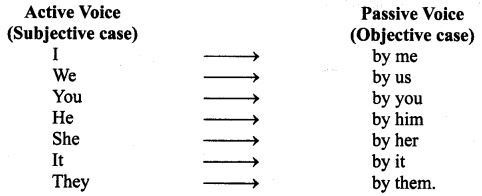Voice (grammar) – “भाषा प्रवीणता परीक्षा विशेष”

‘Voice’ – What Is It?
The term ‘voice’ is a term that is used to denote the form of the verb which shows if the subject in a given sentence is the doer or receiver of the action. The voice of a verb describes the relationship between the action and the participants (subject or object) in a sentence.
The Two Voices in the English Language
There are two voices in the English language and they are as follows:
- Active Voice
- Passive Voice
Let us look into the two voices a little in detail with the help of the meaning and definition given below.
What is the Active Voice? – Meaning and Definition
The active voice, in a sentence, denotes that the noun or pronoun that acts as the subject in the sentence is the doer of the action. In other words, the subject performs the action or acts upon the verb.
According to the Oxford Learner’s Dictionary, the active voice is defined as “the form of a verb in which the subject is the person or thing that performs the action”, and according to the Collins Dictionary, the active voice is defined as “a voice of verbs used to indicate that the subject of a sentence is performing the action or causing the event or process described by the verb.”
What is the Passive Voice? – Meaning and Definition
The passive voice, on the other hand, represents that the subject is one acted upon by the action or verb in the sentence. It can also be said that the passive voice indicates that the subject in the sentence is no longer active but passive.
According to the Oxford Learner’s Dictionary, the passive voice is defined as “the form of a verb used when the subject is affected by the action of the verb”, and according to the Collins Dictionary, the passive voice is “formed using ‘be’ and the past participle of a verb. The subject of a passive clause does not perform the action expressed by the verb but is affected by it.”
Using the Active Voice and the Passive Voice – Points to Remember
There are a few points that you have to bear in mind when using the active voice and the passive voice. In the English language, the active voice is used generally as they give the information in a direct and clear manner. Make sure you do not use the passive voice just because you think it sounds better. Use it only if it is necessary. Remember that the active voice has the subject doing the action and the passive voice has the subject receiving the action. If you want to communicate your thoughts and ideas clearly and effectively, especially in a professional setup, it would be best to use the active voice.
A pro tip for you to master the active voice and the passive voice is to know the structure and formula by which they work.
Active Voice – Subject + Verb + Object
Passive Voice – Object + Verb + Subject
Difference between the Active Voice and the Passive Voice
Analysing the difference between the active voice and the passive voice is what will help you in a much better way to learn how to use the two voices effectively. Take a look at the following table to know how they differ.
| Active Voice | Passive Voice |
|
|
|
|
|
|
|
|
|
|
Rules to be Followed When Converting the Active Voice to the Passive Voice
When converting the active voice into the passive voice or vice versa, there are changes in the tenses and pronouns used in the sentences.
The table given below shows you how the tenses change when converting the active voice to the passive voice and vice versa.
| Conversion Rules for Active Voice and Passive Voice | |||||
| Tense | Voice | Simple Tense | Continuous Tense | Perfect Tense | Perfect Continuous Tense |
| Present | Active | Brendon plays cricket. | Brendon is playing cricket. | Brendon has played cricket. | Brendon has been playing cricket. |
| Passive | Cricket is played by Brendon. | Cricket is being played by Brendon. | Cricket has been played by Brendon. | No Passive | |
| Past | Active | Brendon played cricket. | Brendon was playing cricket. | Brendon had played cricket. | Brendon had been playing cricket. |
| Passive | Cricket was played by Brendon. | Cricket was being played by Brendon. | Cricket had been played by Brendon. | No Passive | |
| Future | Active | Brendon will play cricket. | Brendon will be playing cricket. | Brendon will have played cricket. | Brendon will have been playing cricket. |
| Passive | Cricket will be played by Brendon. | No Passive | Cricket will have been played by Brendon. | No Passive | |
| Change of Pronouns | |
| Active Voice | Passive Voice |
| I | Me |
| We | Us |
| He | Him |
| She | Her |
| They | Them |
| It | It |
Key Points about Voice:
- Active voice is generally more direct and straightforward, often used for clarity and emphasis on the doer of the action.
- Passive voice can be used when the emphasis is on the recipient of the action or when the doer of the action is unknown or less important.
- The construction of passive voice typically involves a form of the verb “to be” (am, is, are, was, were) and the past participle of the main verb.
- Passive voice is often used in scientific or formal writing, but overusing it can lead to unclear or vague writing.
- When converting a sentence in the active voice to the passive voice, the first thing that you have to do is interchange the subject and the object.
- The next part of speech you have to focus on is the verb. When converting the active voice into the passive voice, you just have to convert the main verb into its past participle or its third form. The third form of the main verb is the past participle form of the verb.
- When you are changing the tense of the main verb, make sure you use an auxiliary verb which maintains the tense the sentence represents.
- Always use the preposition, ‘by’ before the subject in a passive sentence.
- If there are any adverbs used in the sentence with the active voice, be sure to include it in the passive voice as well. Do not just drop it when you convert a sentence in the active voice to the passive voice or vice-versa.




